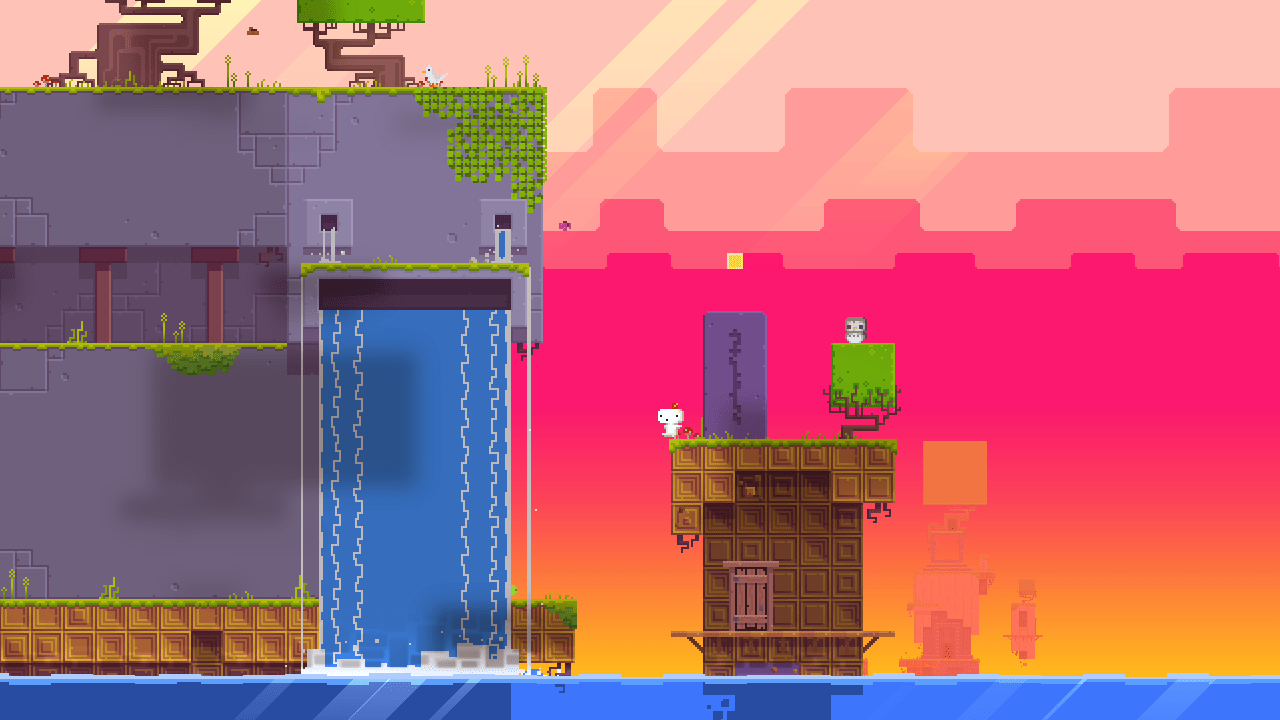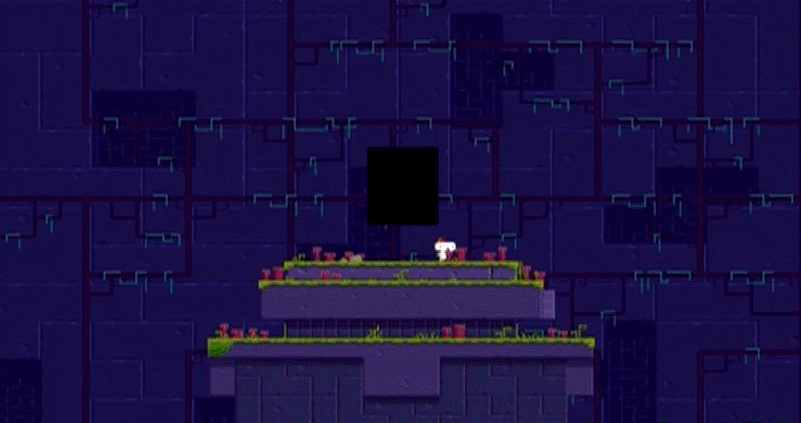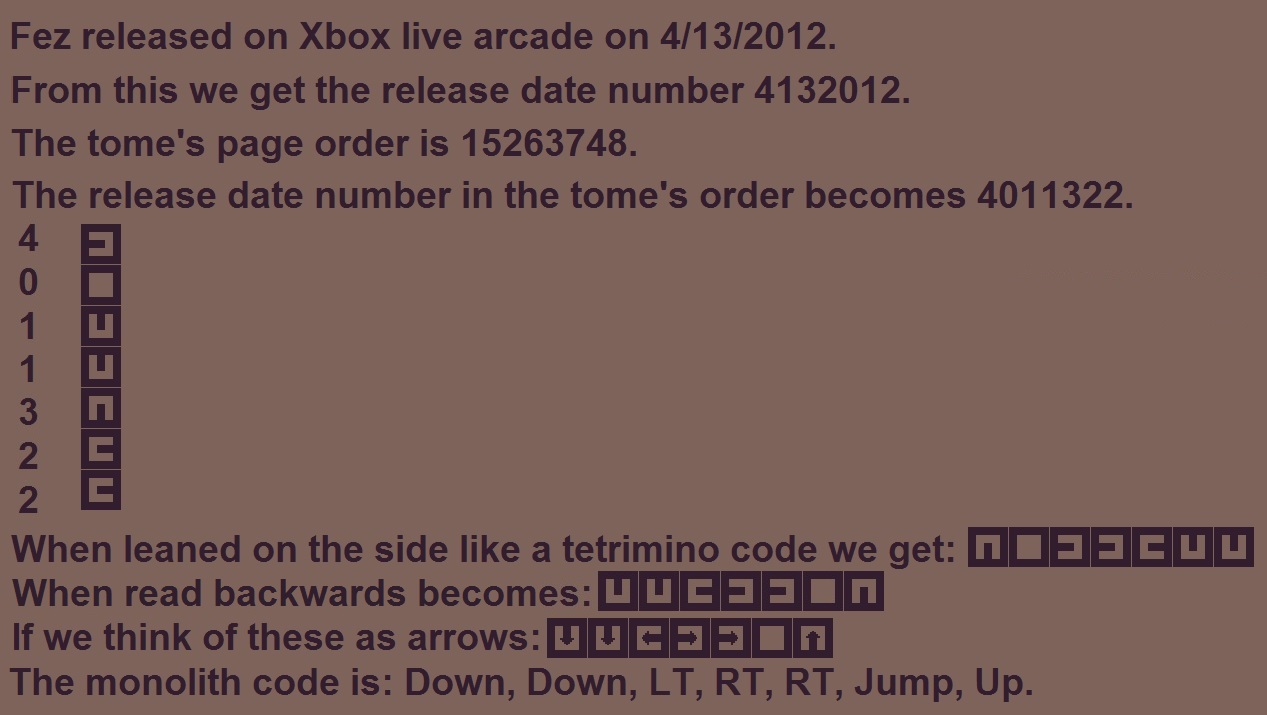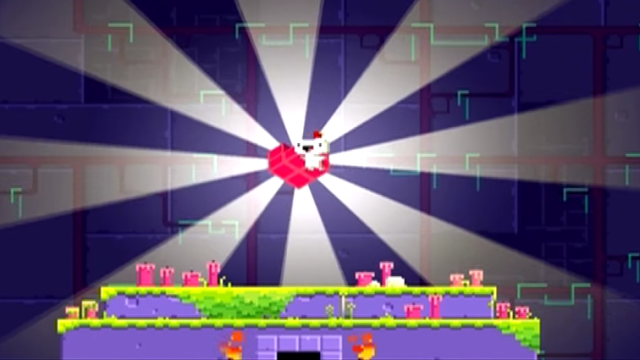Vibrantly-pixelated indie darling Fez turned five years old this week, so it’s the perfect time to celebrate the game’s strangest puzzle and the community of players who devoted themselves to solving it.
Released in April of 2012 on Xbox Live Arcade, Fez seemed like a retro-throwback from an alternate reality; the kind of made-up game kids might play in a Netflix series devoted to 80s styles and cultural touchstones. But while its aesthetic mined an imagined past, the game’s core premise felt irresistibly modern: platform across 2D renderings of a 3D world.
I revisited the game for a few hours this past week and was struck by the how novel the mechanic of turning the world to reveal new paths and secrets still feels. The art is beautiful and Disaterpeace’s soundtrack remains an all time great, but the first time you spin the perspective left or right to see the environment rearranged in a way that feels surprising but intuitive still holds up.
This is just the surface-level appeal of Fez, however. As people who have plumbed its depths in the hope of better understandings its underlying mysteries have discovered, shit only gets weirder from there. But of all the game’s esoteric puzzles and baroque codes, the story behind the “Black Monolith” remains the most unsettling.

In Fez you go around collecting special cubes. If you are really serious about Fez, you also collect secret cubes called “anti-cubes.” And if you’re obsessed with Fez, you try to collect super-secret-special “red cubes.” There are three of the latter, and the final one requires solving the game’s “Black Monolith” puzzle. The only problem is that the Black Monolith isn’t solvable. At least not in the conventional sense.
Beating Fez the first time unlocks a New Game + that doesn’t just carry over progress from the first play through, it also grants players the ability to view the world in first-person. This in turn makes it possible to solve one of the puzzles in an anti-cube chamber.
Using a Tetromino Button Code that required lots of strangers pouring over their notes and random scribes to learn, a torn map in the game can be deciphered to reveal a series of button presses: Up RT Up A Down LT Up Down.
Doing these at a precise location in a certain room, which can only be correctly observed using the game’s first-person view from the New Game +, reveals a floating Black Monolith. I’ve given you the unfairly abbreviated version of this first part, which is also in some ways the “easy” part, because while revealing the mysterious floating shadow of a pillar was immensely difficult in and of itself, what to do with it was what really drove players to their collective wits’ end.

Writing about the event years later, Devin Raposo recounted how the mystery tormented the Fez community,
“Some believed the solution was somehow related to a strange poem about the creation of the universe which could be deciphered through some careful translation of a mysterious tome found elsewhere. Some thought it might have to do with a clue elsewhere in the game they might have missed; others believed it was just a weird thing that had no real meaning or solution whatsoever.”
And so a website was formed where players could go and receive instructions for how to help brute force the puzzle into submission. Clues leaked out from the development team had revealed that like what led the Monolith to appear in the first place, another set of button presses entered somewhere else in the room would “solve” it. As a result, the total possible number of solutions was calculated and players got to work testing them all out.
It took eighteen hours and 66,227 tries to find the answer: Down Down LT RT RT A Up. The only problem? While the red cube lurking in the room had been revealed and finally collected, the fact that no one had been able to discern the hidden logic behind how to solve the puzzle without brute forcing it made the entire affair feel incomplete and unresolved. With as much passion as they took to trying to figure out how to solve the Black Monolith, players took to trying to imbue the puzzle and its apparent solution with some semblance of meaning.
They offered each other theories and in turn shot them down until one became as close to canon as anything else in the game ever was:

And how did the author of this theory come up with their solution? Well there was that time that Phil Phish, the game’s co-creator, mentioned how much of an influence the Monolith scene in 2001 a Space Odyssey was, and also Carl Sagan’s explanation of the fourth dimension.
Take those things and add a bunch of sitting down with the game’s box art mulling over the possible implications of it’s release date and the Tetromino Button Code, and you get a not entirely unconvincing explanation of how someone might have conceivably solved the Black Monolith on the first try.
As Fez players have pointed out over the years, however, even the now canonical explanation of the solution feels like something put together after the fact — a theory that benefits a bit too generously from already knowing the precise details of what it’s supposed to be theorizing. At the same time, there’s something sublime about a solution that’s just as absurd if it’s ultimately true than if it’s not.

Comments
One response to “A Look Back At Fez’s Unsolvable ‘Black Monolith’ Puzzle ”
I tried looking up a spoiler-free explanation/hint of what to do about that. It still left me confused so I just never went back to it 😛
Fantastic game otherwise though.